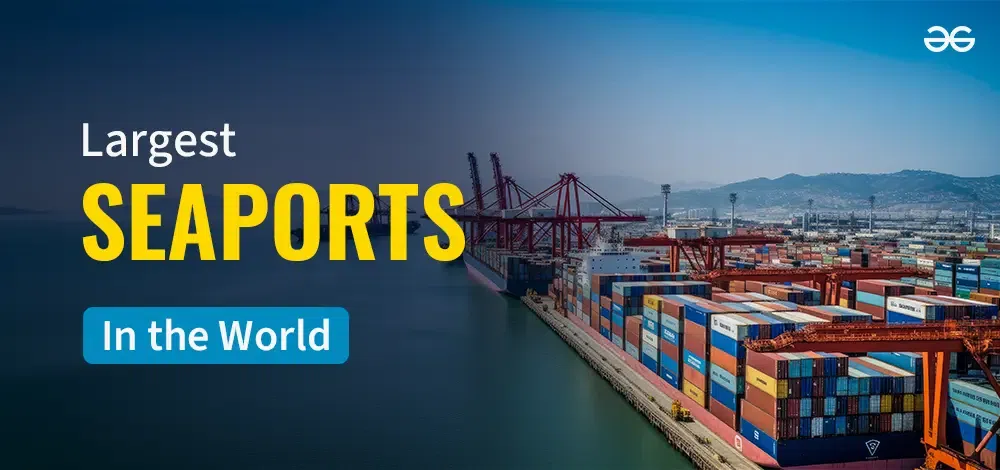In the vast expanse of oceanic trade routes, shipping ports stand as towering pillars of global commerce. These colossal hubs bustle with activity, facilitating the movement of goods that fuel economies and connect nations. Understanding the largest shipping ports in the world is not only crucial for professionals in the freight forwarding and maritime industries but also fascinating for geography enthusiasts eager to grasp the scale of international trade.
Ports are the lifeblood of global trade, serving as the vital link between producers and consumers worldwide. They handle a staggering volume of goods, from raw materials to finished products, ensuring the smooth flow of commerce. In this blog post, we’ll explore the top 10 largest shipping ports globally, shedding light on their significance and the critical role they play in the maritime industry.
Criteria for Ranking
Determining the largest shipping ports involves evaluating several key factors. The most prominent criterion is cargo volume, which measures the total weight of goods passing through a port. Container traffic is another essential metric, reflecting the number of TEUs (twenty-foot equivalent units) handled. Additionally, infrastructure and technological advancements contribute to a port’s ranking, showcasing its ability to efficiently manage and move cargo.
Infrastructure is a port’s backbone, encompassing facilities like cranes, berths, and storage areas. Technological advancements, including automation and digital systems, enhance operational efficiency and reduce turnaround times. Together, these factors form the basis for ranking the world’s largest ports, highlighting their capacity to meet the demands of global trade.
Understanding these criteria allows us to appreciate the complexity and scale of modern ports. As we explore the top 10 largest shipping ports, keep in mind the immense logistical challenges they overcome to maintain their status as global trade powerhouses.
Top 10 List of Largest Shipping Ports
1. Port of Shanghai, China
The Port of Shanghai reigns supreme as the largest shipping port in the world. Located at the Yangtze River Delta, it serves as a crucial gateway for China’s exports and imports. With its advanced container terminals and extensive cargo handling capacity, the port processes over 40 million TEUs annually, connecting China to markets across the globe.
The Port of Shanghai’s strategic location and state-of-the-art facilities make it an indispensable hub in the Asian shipping network. Its ability to handle diverse cargo, from electronics to textiles, underscores its significance in global trade. Additionally, the port’s efficient operations and robust infrastructure continue to attract businesses seeking seamless access to international markets.
2. Port of Singapore, Singapore
Nestled at the crossroads of major shipping routes, the Port of Singapore is a beacon of maritime excellence. Renowned for its cutting-edge technologies and efficient operations, it handles over 37 million TEUs each year. The port’s strategic location near the Strait of Malacca positions it as a key transhipment hub, facilitating trade between Asia, Europe, and the Americas.
Singapore’s port infrastructure is a testament to its commitment to innovation and sustainability. Its automated systems and eco-friendly initiatives set a benchmark for ports worldwide. By offering swift connectivity to global markets, the Port of Singapore remains a vital player in the maritime industry’s evolution.
3. Port of Ningbo-Zhoushan, China
The Port of Ningbo-Zhoushan showcases China’s prowess in logistics and trade. Situated along the eastern coast, it boasts a remarkable cargo volume, handling over 34 million TEUs annually. Its deep-water berths and state-of-the-art terminals accommodate vast vessels, contributing to China’s economic growth.
Ningbo-Zhoushan’s emphasis on technology-driven operations ensures seamless cargo movement. The port’s role in facilitating trade between China and its partners underscores its importance in the global shipping landscape. Its strategic investments in infrastructure and sustainability further solidify its position as a key maritime hub.
4. Port of Shenzhen, China
Shenzhen’s rapid rise as a global trade powerhouse is exemplified by its bustling port. Handling over 27 million TEUs each year, the Port of Shenzhen is a testament to China’s manufacturing prowess. Located in the Pearl River Delta, it serves as a critical link in the global supply chain, connecting producers with consumers worldwide.
The port’s modern facilities and efficient logistics operations attract businesses seeking reliable trade solutions. Shenzhen’s commitment to technological innovation and sustainable practices ensures its continued growth as a leading maritime centre. Its impact on global trade resonates far beyond China’s borders.
5. Port of Guangzhou, China
The Port of Guangzhou stands as a testament to China’s maritime heritage and modern capabilities. Processing over 21 million TEUs annually, it plays a pivotal role in the country’s trade network. Located in the Guangdong province, the port’s strategic position facilitates commerce between China and Southeast Asia.
Guangzhou’s investment in infrastructure and technology enhances its operational efficiency, making it a preferred choice for businesses seeking seamless trade solutions. The port’s commitment to sustainability and environmental stewardship further cements its status as a key player in global shipping.
6. Port of Busan, South Korea
The Port of Busan embodies South Korea’s economic dynamism and maritime expertise. With a cargo volume exceeding 21 million TEUs, it ranks among the world’s largest ports. Situated on the southeastern coast, Busan serves as a vital gateway for trade between Asia and the rest of the world.
Busan’s emphasis on technological innovation and logistics excellence ensures swift cargo movement. The port’s strategic investments in infrastructure and connectivity bolster its role as a major transhipment hub. Its contribution to South Korea’s economy and global trade is undeniable.
7. Port of Hong Kong, Hong Kong
Hong Kong’s status as a global financial centre is mirrored by its bustling port. Handling over 18 million TEUs annually, the Port of Hong Kong is a linchpin in international trade. Its strategic location and efficient operations attract businesses seeking seamless access to Asian markets.
The port’s dedication to technological advancement and sustainability underscores its commitment to excellence. Hong Kong’s role as a transhipment hub and trade facilitator resonates across the maritime industry, solidifying its position as a key player in global commerce.
8. Port of Qingdao, China
Qingdao’s port exemplifies China’s maritime ambitions and logistical capabilities. Processing over 18 million TEUs, it stands as a testament to China’s prowess in global trade. Situated on the eastern coast, Qingdao serves as a vital gateway for commerce between China and its partners.
The port’s investments in infrastructure and technology enhance its operational efficiency, making it a preferred choice for businesses seeking reliable trade solutions. Qingdao’s commitment to sustainability and environmental stewardship further cements its status as a key player in global shipping.
9. Port of Tianjin, China
Tianjin’s port showcases China’s dedication to economic growth and maritime excellence. Handling over 16 million TEUs annually, it plays a pivotal role in the country’s trade network. Located near Beijing, Tianjin serves as a critical link in the global supply chain, connecting producers with consumers worldwide.
The port’s modern facilities and efficient logistics operations attract businesses seeking reliable trade solutions. Tianjin’s commitment to technological innovation and sustainable practices ensures its continued growth as a leading maritime centre. Its impact on global trade resonates far beyond China’s borders.
10. Port of Jebel Ali, United Arab Emirates
Jebel Ali’s port embodies the UAE’s economic dynamism and maritime expertise. With a cargo volume exceeding 15 million TEUs, it ranks among the world’s largest ports. Situated in Dubai, Jebel Ali serves as a vital gateway for trade between the Middle East and the rest of the world.
The port’s strategic investments in infrastructure and connectivity bolster its role as a major transhipment hub. Jebel Ali’s emphasis on technological innovation and logistics excellence ensures swift cargo movement. Its contribution to the UAE’s economy and global trade is undeniable.
Port Operations and Technologies
The efficient operation of mega-ports hinges on cutting-edge technologies and strategic innovations. Automation is revolutionising port operations, enhancing cargo handling and reducing reliance on manual labour. Automated cranes, guided vehicles, and robotic systems streamline processes, ensuring swift movement of goods.
Digitalisation plays a crucial role in optimising port operations. Advanced software and data analytics provide real-time insights into cargo flows, enabling timely decision-making. Ports are increasingly adopting blockchain technology to enhance transparency and security in supply chain operations.
Sustainability is a key focus for modern ports. Eco-friendly practices, such as electrification and emissions reduction, contribute to environmental conservation. Ports are investing in renewable energy sources and green technologies to minimise their carbon footprint, aligning with global efforts to combat climate change.
Impact on Global Trade
The influence of these mega-ports on global trade is profound. Serving as vital conduits for goods, they facilitate seamless commerce between continents. Ports play a critical role in supply chain networks, ensuring the timely delivery of raw materials and finished products.
The strategic location of these ports enhances their impact on trade routes. Positioned at key crossroads, they enable efficient transhipment and distribution of goods. Ports act as economic catalysts, attracting businesses and fostering regional development.
The interconnectedness of global trade relies on the smooth functioning of these ports. Their ability to handle immense cargo volumes and adapt to changing demands ensures the resilience and stability of international commerce. Ports are indispensable players in the intricate web of global trade.
Challenges Faced
Despite their significance, large shipping ports face a myriad of challenges. Environmental concerns, such as water pollution and habitat disruption, necessitate proactive strategies to mitigate their impact. Ports are adopting eco-friendly practices to balance economic growth with environmental stewardship.
Labour issues, including workforce shortages and labour disputes, can disrupt port operations. Ports are investing in training programs and technology-driven solutions to address these challenges. Collaboration between port authorities and labour unions is essential to maintaining operational efficiency.
Infrastructure development is a continuous challenge for ports seeking to accommodate growing cargo volumes. Expanding facilities, upgrading equipment, and enhancing connectivity require substantial investments. Ports must balance development with sustainability and community interests.
Future of Shipping Ports
The future of shipping ports is characterised by technological advancements and evolving trade dynamics. Automation will continue to reshape port operations, enhancing efficiency and reducing costs. Ports will increasingly rely on data-driven insights to optimise logistics and improve decision-making.
Sustainability will remain a key focus, with ports adopting green technologies and practices to minimise their environmental impact. Ports will play a pivotal role in advancing the transition to renewable energy sources and supporting global sustainability goals.
The integration of digital platforms and blockchain technology will enhance transparency and security in supply chain operations. Ports will become hubs of innovation, fostering collaboration between stakeholders and driving the evolution of the maritime industry.
Conclusion
The top 10 largest shipping ports exemplify the scale and complexity of global trade. From Shanghai to Jebel Ali, these mega-ports are vital players in the maritime industry, driving economic growth and facilitating international commerce. Understanding their significance provides insights into the intricate web of global trade.
While challenges persist, the future of shipping ports is promising. Technological advancements and sustainability initiatives will shape the trajectory of the maritime industry. By staying informed and engaged, you can be part of the exciting developments in the world of shipping.

